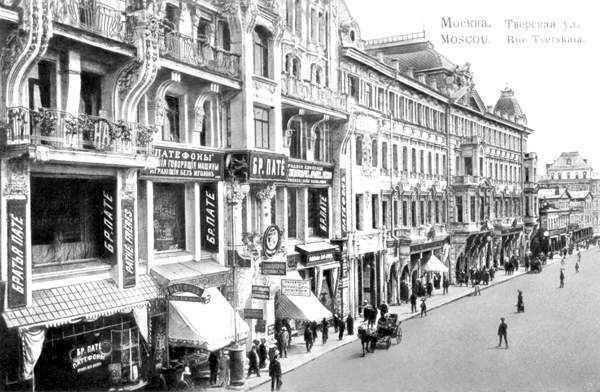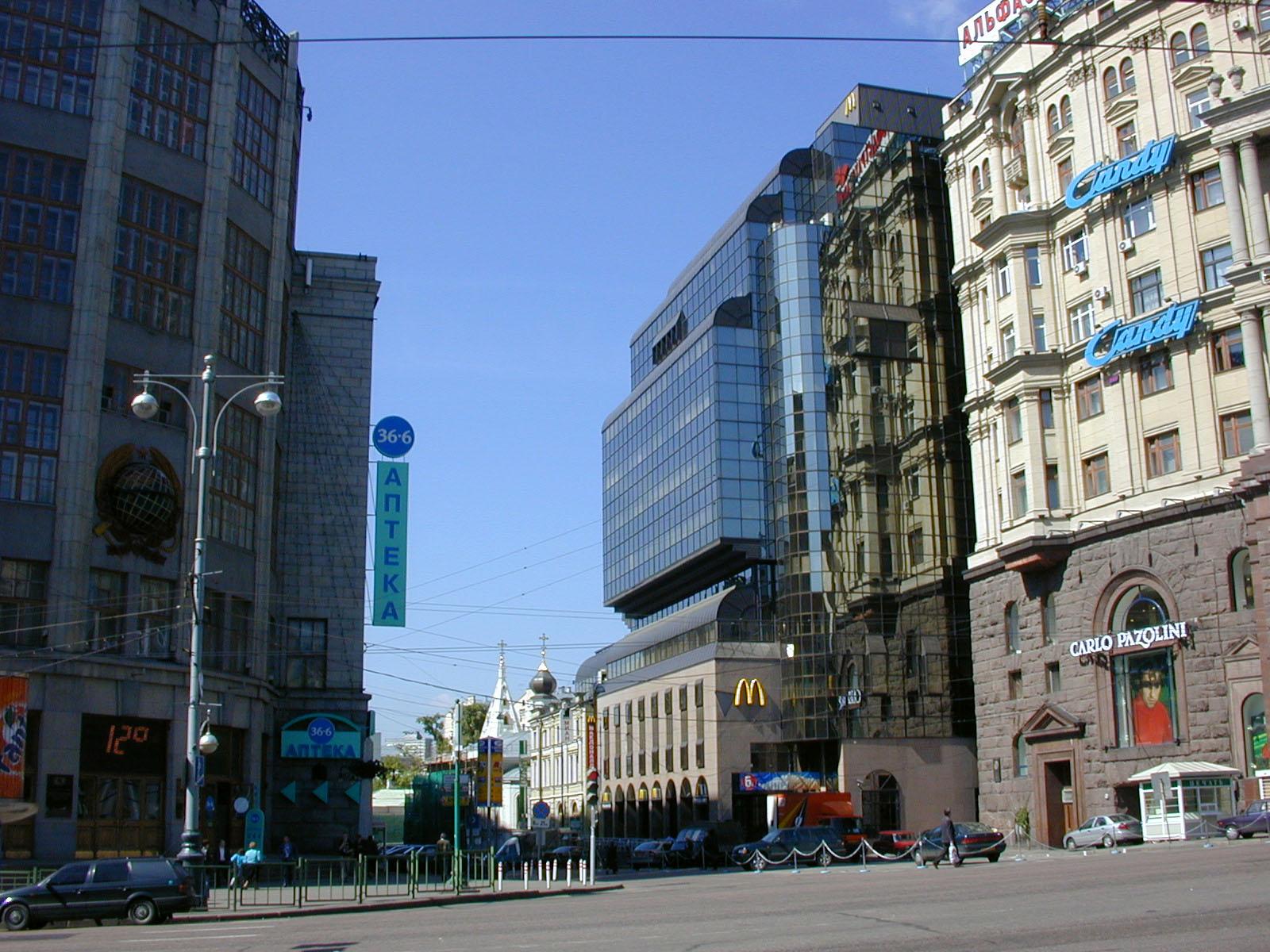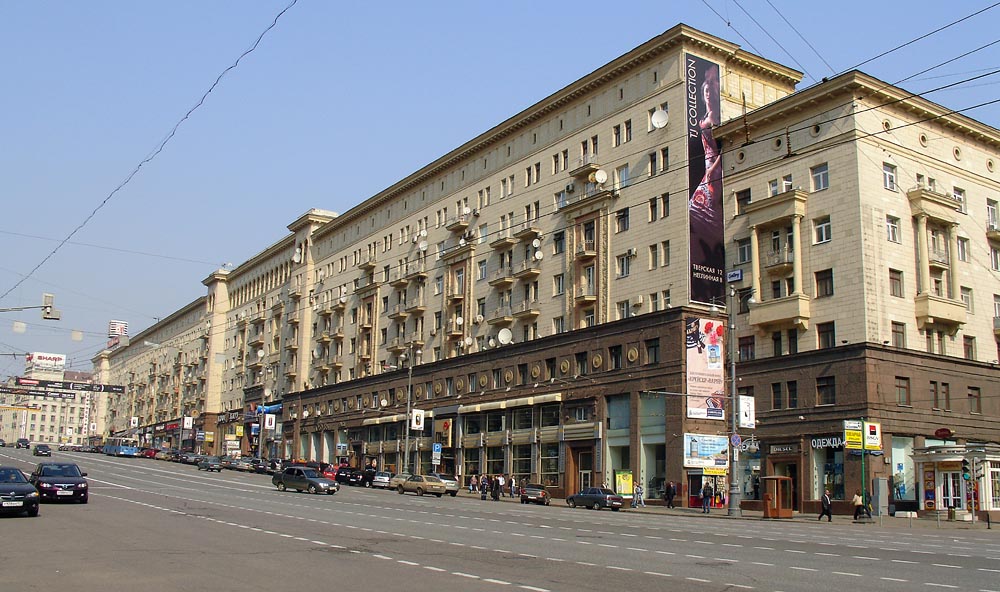Tverskaya Street on:
[Wikipedia]
[Google]
[Amazon]
 Tverskaya Street ( rus, Тверская улица, p=tvʲɪrˈskajə ˈulʲɪt͡sə), known between 1935 and 1990 as Gorky Street (russian: улица Горького), is the main radial street in
Tverskaya Street ( rus, Тверская улица, p=tvʲɪrˈskajə ˈulʲɪt͡sə), known between 1935 and 1990 as Gorky Street (russian: улица Горького), is the main radial street in
 During
During
 Between the
Between the
"Gorky Street Loses Name as Muscovites Reach for Past"
 Tverskaya Street ( rus, Тверская улица, p=tvʲɪrˈskajə ˈulʲɪt͡sə), known between 1935 and 1990 as Gorky Street (russian: улица Горького), is the main radial street in
Tverskaya Street ( rus, Тверская улица, p=tvʲɪrˈskajə ˈulʲɪt͡sə), known between 1935 and 1990 as Gorky Street (russian: улица Горького), is the main radial street in Moscow
Moscow ( , US chiefly ; rus, links=no, Москва, r=Moskva, p=mɐskˈva, a=Москва.ogg) is the capital and largest city of Russia. The city stands on the Moskva River in Central Russia, with a population estimated at 13.0 million ...
. The street runs Northwest from the central Manege Square in the direction of Saint Petersburg
Saint Petersburg ( rus, links=no, Санкт-Петербург, a=Ru-Sankt Peterburg Leningrad Petrograd Piter.ogg, r=Sankt-Peterburg, p=ˈsankt pʲɪtʲɪrˈburk), formerly known as Petrograd (1914–1924) and later Leningrad (1924–1991), i ...
and terminates at the Garden Ring, giving the name to Tverskoy District
Tverskoy District ( rus, Тверско́й райо́н, p=tvʲɪrˈskoj, a=Ru-Тверской.ogg) is a district of Central Administrative Okrug of the federal city of Moscow, Russia. Population:
The district extends from Kitai-gorod no ...
. The route continues further as First Tverskaya-Yamskaya Street, Leningradsky Avenue
Leningradsky Prospekt (russian: Ленингра́дский проспе́кт), or Leningrad Avenue, is a major arterial avenue in Moscow, Russia. It continues the path of Tverskaya Street and 1st Tverskaya-Yamskaya Street north-west from Be ...
and Leningradskoye Highway.
History and architecture
Middle Ages to 18th century
Tourists are told that Tverskaya Street existed as early as the 12th century. Its importance for the medieval city was immense, as it connected Moscow with its superior, and later chief rival,Tver
Tver ( rus, Тверь, p=tvʲerʲ) is a city and the administrative centre of Tver Oblast, Russia. It is northwest of Moscow. Population:
Tver was formerly the capital of a powerful medieval state and a model provincial town in the Russi ...
. At that time, the thoroughfare crossed the Neglinnaya River. The first stone bridge across the Neglinnaya was set up in 1595.
In the 17th and 18th centuries, Tverskaya Street was renowned as the centre of Moscow's social life. The nobility considered it fashionable to settle in this district. Among the Palladian
Palladian architecture is a European architectural style derived from the work of the Venetian architect Andrea Palladio (1508–1580). What is today recognised as Palladian architecture evolved from his concepts of symmetry, perspective and ...
mansions dating from the reign of Catherine the Great
, en, Catherine Alexeievna Romanova, link=yes
, house =
, father = Christian August, Prince of Anhalt-Zerbst
, mother = Joanna Elisabeth of Holstein-Gottorp
, birth_date =
, birth_name = Princess Sophie of Anha ...
are the residence of the mayor of Moscow (1778–82, rebuilt in ), and the English Club (1780s). The mayor's residence among a number of other historic buildings was moved about 14 meters for the widening of the Gorky Street during Stalin's time. On the square before it stands a statue of the legendary founder of Moscow, Yuri Dolgoruky
Yuri I Vladimirovich ( rus, Юрий Владимирович, Yuriy Vladimirovich), commonly known as Yuri Dolgorukiy or the Long Arm ( rus, Юрий Долгорукий, Yuriy Dolgorukiy, meaning "Far-Reaching", c. 109915 May 1157) was a Rur ...
, erected for the city's 800th anniversary.
During the imperial period, the importance of the thoroughfare was highlighted by the fact that it was through this street that the tsars arrived from the Northern capital to stay at their Kremlin residence. Several triumphal arch
A triumphal arch is a free-standing monumental structure in the shape of an archway with one or more arched passageways, often designed to span a road. In its simplest form a triumphal arch consists of two massive piers connected by an arch, cr ...
es were constructed to commemorate coronation ceremonies. In 1792, the Tverskaya Square was laid out before the residence of the governor of Moscow as a staging ground for mass processions and parades. In 1947, the square was decorated with an equestrian statue of Prince Yury Dolgoruky, founder of Moscow.
19th century
Pushkin
Alexander Sergeyevich Pushkin (; rus, links=no, Александр Сергеевич ПушкинIn pre-Revolutionary script, his name was written ., r=Aleksandr Sergeyevich Pushkin, p=ɐlʲɪkˈsandr sʲɪrˈɡʲe(j)ɪvʲɪtɕ ˈpuʂkʲɪn, ...
's time, the Tverskaya was lined with five churches. The poet wove his impressions from the street into the following stanza of ''Eugene Onegin
''Eugene Onegin, A Novel in Verse'' (Reforms of Russian orthography, pre-reform Russian: ; post-reform rus, Евгений Оне́гин, ромáн в стихáх, p=jɪvˈɡʲenʲɪj ɐˈnʲeɡʲɪn, r=Yevgeniy Onegin, roman v stikhakh) is ...
'':
Towards the end of the 19th century, the street was reconstructed, with stately neoclassical mansions giving way to grandiose commercial buildings in an eclectic mixture of historical styles. A characteristic edifice of the time is the eclectic
Eclectic may refer to:
Music
* ''Eclectic'' (Eric Johnson and Mike Stern album), 2014
* ''Eclectic'' (Big Country album), 1996
* Eclectic Method, name of an audio-visual remix act
* Eclecticism in music, the conscious use of styles alien to th ...
Hotel National, Moscow (1901-1903), whose interior is a landmark of Russian Art Nouveau
Art Nouveau (; ) is an international style of art, architecture, and applied art, especially the decorative arts. The style is known by different names in different languages: in German, in Italian, in Catalan, and also known as the Modern ...
. In 1888 the actor, theatre director and founder of the Moscow Art Theatre
The Moscow Art Theatre (or MAT; russian: Московский Художественный академический театр (МХАТ), ''Moskovskiy Hudojestvenny Akademicheskiy Teatr'' (МHАТ)) was a theatre company in Moscow. It was f ...
, Constantin Stanislavski
Konstantin Sergeyevich Stanislavski ( Alekseyev; russian: Константин Сергеевич Станиславский, p=kənstɐnʲˈtʲin sʲɪrˈgʲejɪvʲɪtɕ stənʲɪˈslafskʲɪj; 7 August 1938) was a seminal Russian Soviet Fe ...
, rented the Ginzburg House on the street and had it converted into a luxurious clubhouse with its own large stage and several exhibition rooms, in order to house his newly formed Society of Art and Literature. The Society gave its last performance there on 3 January 1891 and the building burnt down on the night of January 10.Benedetti (1999, 42).
Modern history
Russian Revolution of 1917
The Russian Revolution was a period of political and social revolution that took place in the former Russian Empire which began during the First World War. This period saw Russia abolish its monarchy and adopt a socialist form of government ...
and the rise of Stalinist architecture in mid-1930s, the street acquired three modernist buildings - constructivist Izvestia Building by Grigory Barkhin Grigory, Grigori and Grigoriy are Russian masculine given names.
It may refer to watcher angels or more specifically to the egrḗgoroi or Watcher angels.
Grigory
* Grigory Baklanov (1923–2009), Russian novelist
* Grigory Barenblatt (1927201 ...
(1925–1927, Pushkin Square
Pushkinskaya Square or Pushkin Square () is a pedestrian open space in the Tverskoy District in central Moscow. Historically, it was known as ''Strastnaya Square'' before being renamed for Alexander Pushkin in 1937.
It is located at the juncti ...
), Central Telegraph Building (1927-29, 7 Tverskaya), a modernist
Modernism is both a philosophy, philosophical and arts movement that arose from broad transformations in Western world, Western society during the late 19th and early 20th centuries. The movement reflected a desire for the creation of new fo ...
masterpiece by Ivan Rerberg, and a stern "black cube
In geometry, a cube is a three-dimensional solid object bounded by six square faces, facets or sides, with three meeting at each vertex. Viewed from a corner it is a hexagon and its net is usually depicted as a cross.
The cube is the only ...
" of the Lenin Institute in Tverskaya Square (1926) by Stepan Chernyshyov. The street was renamed in 1932 for Maxim Gorky
Alexei Maximovich Peshkov (russian: link=no, Алексе́й Макси́мович Пешко́в; – 18 June 1936), popularly known as Maxim Gorky (russian: Макси́м Го́рький, link=no), was a Russian writer and social ...
, the Russian writer and revolutionary admired by both Vladimir Lenin
Vladimir Ilyich Ulyanov. ( 1870 – 21 January 1924), better known as Vladimir Lenin,. was a Russian revolutionary, politician, and political theorist. He served as the first and founding head of government of Soviet Russia from 1917 to 1 ...
and Josef Stalin
Joseph Vissarionovich Stalin (born Ioseb Besarionis dze Jughashvili; – 5 March 1953) was a Georgian revolutionary and Soviet political leader who led the Soviet Union from 1924 until his death in 1953. He held power as General Secreta ...
.Parks, Michael."Gorky Street Loses Name as Muscovites Reach for Past"
Los Angeles Times
The ''Los Angeles Times'' (abbreviated as ''LA Times'') is a daily newspaper that started publishing in Los Angeles in 1881. Based in the LA-adjacent suburb of El Segundo since 2018, it is the sixth-largest newspaper by circulation in the ...
(July 29, 1990).
Further expansion occurred in line with Joseph Stalin
Joseph Vissarionovich Stalin (born Ioseb Besarionis dze Jughashvili; – 5 March 1953) was a Georgian revolutionary and Soviet Union, Soviet political leader who led the Soviet Union from 1924 until his death in 1953. He held power as Ge ...
's 1935 master plan. During that period, all the churches and most other historic buildings were torn down in order to widen the street and replace low-rise buildings with larger, early Stalinist apartment blocks and government offices. Arkady Mordvinov, who handled this ambitious project, retained some historical buildings, like the ornately decorated Savvinskoye Podvorye by Ivan Kuznetsov. This building was moved to a new foundation North from the new street line, and is now completely enclosed inside Mordvinov's Stalinist block at 6, Tverskaya Street.
The project was only partially completed before World War II
World War II or the Second World War, often abbreviated as WWII or WW2, was a world war that lasted from 1939 to 1945. It involved the World War II by country, vast majority of the world's countries—including all of the great power ...
; more Stalinist blocks appeared in the 1940s and 1950s, still leaving a lot of 19th-century buildings. Most of them were torn down later, with a few exceptions like Yermolova Theatre
The Yermolova Theatre (russian: Москóвский теáтр им. М. Н. Ермóловой) is a theatre company in the Tverskoy District of central Moscow. It is under the artistic direction of Vladimir Andreyev (russian: Владимир � ...
still standing. Hotel Intourist, a 22-story tower built in 1970, was demolished in 2002 and replaced by the Ritz-Carlton Hotel Moscow.
When Soviet President Mikhail Gorbachev
Mikhail Sergeyevich Gorbachev (2 March 1931 – 30 August 2022) was a Soviet politician who served as the 8th and final leader of the Soviet Union from 1985 to the country's dissolution in 1991. He served as General Secretary of the Com ...
assumed power, he encouraged a return to the country's old Russian names. Thus, the street's name became "Tverskaya Street" again, after a 55-year interlude as Gorky Street.
Layout and functions
Tverskaya Street runs from the Manege Square through theTverskoy District
Tverskoy District ( rus, Тверско́й райо́н, p=tvʲɪrˈskoj, a=Ru-Тверской.ogg) is a district of Central Administrative Okrug of the federal city of Moscow, Russia. Population:
The district extends from Kitai-gorod no ...
and the crossing with the Boulevard Ring
The Boulevard Ring (russian: Бульва́рное кольцо́; transliteration: ''Bulvarnoye Koltso'') is Moscow's second innermost ring road (the first is formed by the Central Squares of Moscow running along the former walls of Kitai-goro ...
, known as Pushkin Square
Pushkinskaya Square or Pushkin Square () is a pedestrian open space in the Tverskoy District in central Moscow. Historically, it was known as ''Strastnaya Square'' before being renamed for Alexander Pushkin in 1937.
It is located at the juncti ...
, to the Garden Ring. Its extension, First Tverskaya-Yamskaya Street, continues further on Northwest right up to Belorussky Rail Terminal
Belorussky railway terminal (russian: Белору́сский вокза́л, ) is a passenger terminal at the ''Moscow–Passenger–Smolenskaya'' railway station (russian: Москва́-Пассажирская-Смоле́нская, also k ...
(Tverskaya Zastava Square), changing its name again into Leningradsky Prospekt
Leningradsky Prospekt (russian: Ленингра́дский проспе́кт), or Leningrad Avenue, is a major arterial avenue in Moscow, Russia. It continues the path of Tverskaya Street and 1st Tverskaya-Yamskaya Street north-west from Be ...
. It keeps the same direction before diverging into Volokolamskoye Shosse and Leningradskoye Shosse
The M10 "Russia" (russian: "Россия") is a federal highway in Russia connecting the country's two largest cities, Moscow and Saint Petersburg. Other than in the vicinity of Moscow and Saint Petersburg, the M10 is basically a two-lane highway ...
(''Leningrad
Saint Petersburg ( rus, links=no, Санкт-Петербург, a=Ru-Sankt Peterburg Leningrad Petrograd Piter.ogg, r=Sankt-Peterburg, p=ˈsankt pʲɪtʲɪrˈburk), formerly known as Petrograd (1914–1924) and later Leningrad (1924–1991), i ...
Highway'').
Tverskaya Street is the most expensive shopping street in Moscow and Russia. According to an index published by global real estate company Colliers International in 2008, it is now the third most expensive street in the world, based on commercial rental fees. It is the center of the city's nightlife
Nightlife is a collective term for entertainment that is available and generally more popular from the late evening into the early hours of the morning. It includes pubs, bars, nightclubs, parties, live music, concerts, cabarets, theatre, ...
and entertainment
Entertainment is a form of activity that holds the attention and interest of an audience or gives pleasure and delight. It can be an idea or a task, but is more likely to be one of the activities or events that have developed over thousa ...
.
Reconstruction plan, 2007-2009
Plans for the reconstruction of the Tverskaya radius into a grade-separated freeway, already under way in remote parts of the route (see Leningradsky Prospekt Reconstruction for a complete schedule), have been authorized for Tverskaya Zastava andPushkin Square
Pushkinskaya Square or Pushkin Square () is a pedestrian open space in the Tverskoy District in central Moscow. Historically, it was known as ''Strastnaya Square'' before being renamed for Alexander Pushkin in 1937.
It is located at the juncti ...
in April, 2007, to be completed in 2009. Work is already underway at the first location. Both squares will acquire complex multi-level, grade-separated crossings and underground shopping malls, despite objections from preservationist Preservationist is generally understood to mean ''historic preservationist'': one who advocates to preserve architecturally or historically significant buildings, structures, objects, or sites from demolition or degradation. Historic preservation us ...
s and traffic experts.
See also
*List of upscale shopping districts
A shopping street or shopping district is a designated road or quarter of a city/town that is composed of individual retail establishments (such as stores, boutiques, restaurants, and shopping complexes). Such areas will typically be pedest ...
References
Sources
* Benedetti, Jean. 1999. ''Stanislavski: His Life and Art''. Revised edition. Original edition published in 1988. London: Methuen. . {{coord, 55, 45, 26, N, 37, 36, 53, E, display=title, region:RU-MOW_type:landmark_source:dewiki Streets in Moscow Tourist attractions in Moscow Shopping districts and streets in Russia Tverskoy District Maxim Gorky